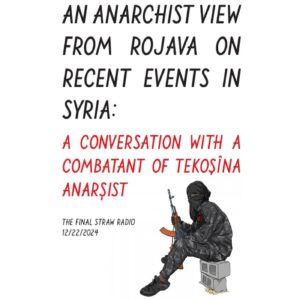
This week, we’re sharing a conversation with Errico, a combatant member of Tekoşîna Anarşist, an internationalist anarchist formation in critical solidarity with the Rojava Revolution. For this episode, Errico answers some questions we had about what’s been happening in Syria and concerns from within the Democratic Autonomous Administration of North and East Syria. You can find ideas and updates from the TA formation on their blog, https://tekosinaanarsist.noblogs.org. Past interviews with TA can be found here.
- Transcript in English
- Transkrypcja polska
- 中文稿
- PDF (Unimposed)
- Zine (Imposed PDF)
Errico’s voice has been re-recorded by a comrade for anonymity. The transcript is already up in the show notes and at our website for easier reading, translation and sharing and you can find past interviews we’ve done with TA linked in the show notes. And there is an announce-only signal group that anyone can join with updates and analysis by anarchists in the region or paying attention which we’ll link in our shownotes. Just a headsup, the usernames of members of this group will be visible to the all other users there and it might be a good opportunity to set up your signal username and make your phone number unfindable for better anonymity prior to joining the signal group ( https://signal.group/#CjQKIN0TDK_nsHV4uXRtLIdaUOL2R6yv7uvRs8c3RUiXLr-EEhBPEntGCDqJQOD4pzU36i6O )
We simultaneously recorded an interview with Cedric and Khuzama, two libertarian communists and editors of and contributors to the blog Interstices-Fajawat.org about their insights into Syria. This interview will be coming out soon, so keep an eye on our feed.
. … . ..
Featured Track:
- Rojava Punks by Emperor X from The Lakes of Zones B and C
